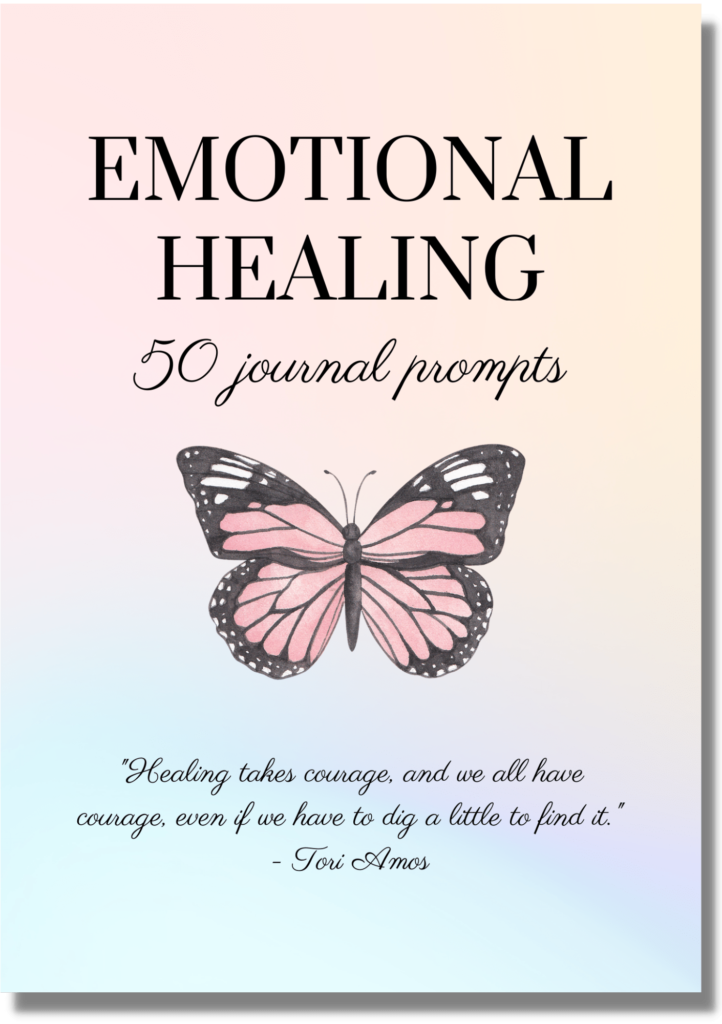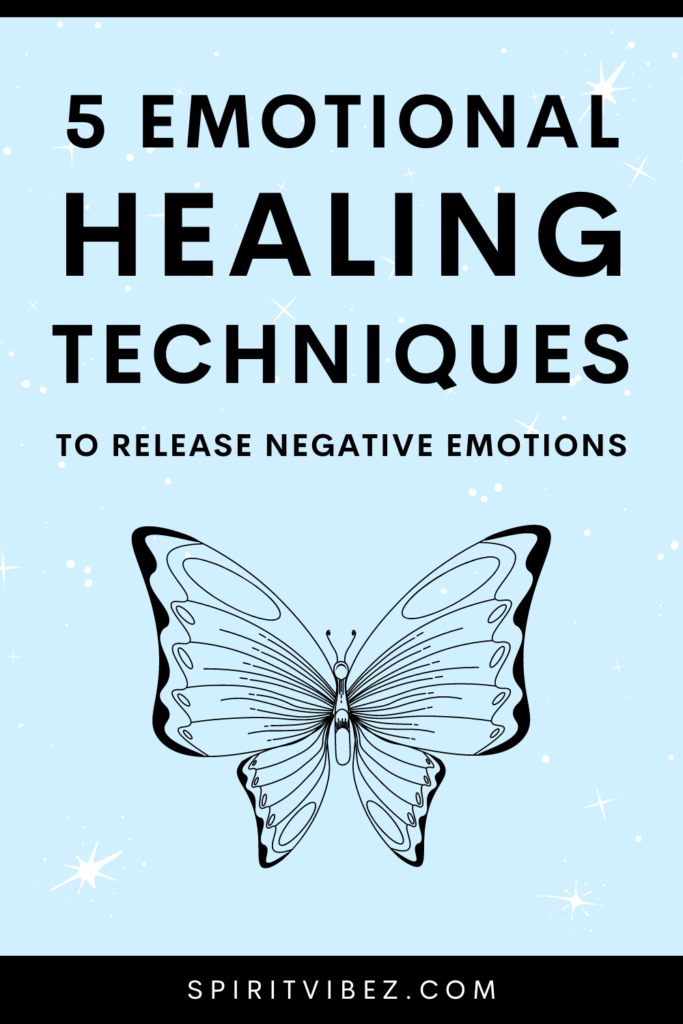Last Updated on September 10, 2023

Emotional healing is a journey that requires time, patience, and the right tools. Whether you are dealing with past traumas, a broken heart, or negative emotions, there exist effective emotional healing techniques that will help you heal and move forward.
In today’s article, we will take a closer look at five powerful emotional healing techniques to release negative emotions. So, take a deep breath, and let’s begin the journey of emotional healing together.
If you haven’t read my previous article on how to heal yourself emotionally and the stages of the healing process, I recommend you check it out first.
5 Powerful emotional healing techniques
From journaling to breathing exercises, these emotional self-healing techniques can release negative emotions, not to mention help reduce stress and anxiety and promote self-awareness and self-acceptance.
Journaling
Writing down your thoughts and feelings can be a powerful way to process and release negative emotions. Journaling can help to provide insight into your feelings and emotions, as well as help you process and understand them better. It can also help promote self-awareness and self-expression, which is beneficial for emotional healing.
To begin journaling, find a quiet place to sit, grab a journal and pen, and start writing about whatever comes to mind. You can also try journal prompts if you think it’s hard to know what to write.
Here are five journal prompts to support emotional healing:
- Reflect on a traumatic event or difficult experience in your life. Write your thoughts and feelings about it and how it has affected you.
- Write a letter to yourself from a compassionate and understanding perspective. What words of comfort and encouragement would you offer to yourself in your current emotional state?
- Think about a time when you felt deeply connected to yourself and others. What were the circumstances and how did it make you feel? Reflect on how you can recreate that feeling of connection in your life.
- Write down any negative thoughts or beliefs you have about yourself. Challenge those thoughts by writing evidence that contradicts them.
- Think about a past accomplishment or achievement that made you feel proud. Reflect on the emotions and feelings that came with that accomplishment and how it has impacted you. Use it as a reminder that you are capable of overcoming challenges and achieving your goals.
These prompts are just a starting point, you can also create your own prompts. Remember that journaling is a personal practice, and you should feel free to express yourself in your own way.
If you want more journal prompts for emotional healing, check out the printable journal I created with powerful prompts to heal yourself emotionally.

Find 50 inspirational healing journal prompts to help you through a difficult time and guide you on your healing journey. You’ll discover what you need to heal and how you can get there, while also learning more about yourself and past traumas that might still affect you today!
Mindfulness meditation
Mindfulness meditation is another healing technique that involves sitting in a quiet place and focusing on your breath while letting go of any distracting thoughts that may come up. This technique can help to reduce stress and anxiety and promote a sense of inner peace. It can also help improve self-awareness and emotional regulation, which can help with the healing process.
To practice this technique, find a quiet place to sit, close your eyes, and focus on your breath. When you notice your mind is wandering, gently bring your attention back to your breath.
Breathing exercises
Taking slow, deep breaths can help you relax and release tension in the body. Breathing exercises to release negative emotions can be done through techniques such as diaphragmatic breathing and alternate nostril breathing.
Diaphragmatic breathing, also known as belly breathing, is a technique that engages the diaphragm muscle to expand the stomach and lungs instead of just the chest.
Here’s how you practice diaphragmatic breathing:
- Sit or lie down in a comfortable position.
- Place one hand on your chest and the other on your belly.
- Slowly inhale through your nose, allowing your belly to rise as you fill your lungs with air. Your chest should remain relatively still.
- Exhale slowly through your mouth, pushing the air out of your lungs and allowing your belly to fall.
- Repeat for several minutes and focus on the sensation of the breath moving in and out of your body.
Alternate nostril breathing, also known as Nadi Shodhana is a yoga breathing technique that can help balance the nervous system, improve lung capacity, and calm the mind.
Here’s how you practice alternate nostril breathing:
- Sit in a comfortable position with your back straight.
- Use your right hand to close your right nostril with your thumb and inhale through your left nostril.
- Close your left nostril with your ring and little finger and exhale through your right nostril.
- Inhale through your right nostril, then close it and exhale through your left nostril.
- Continue alternating nostrils with each inhale and exhale.
- Practice for several minutes focusing on the sensation of the breath moving in and out of your body and the feeling of balance and relaxation that it brings.
Art therapy
This technique involves using art to express and process emotions. It can be a powerful tool for emotional healing as it can help to provide a creative outlet for emotions that may be difficult to express in words. It can also help promote self-expression, self-awareness, and self-acceptance, which are beneficial for emotional healing.
To practice this technique, you can find a quiet place to sit and grab some art supplies, start to draw, or paint whatever comes to mind. For more about art therapy and the different techniques, check out my previous article on how art therapy can help you heal.
Yoga
Yoga can be a powerful tool for emotional healing as it helps to release tension from the body and calm the mind. Practicing yoga can help to promote relaxation, reduce stress and anxiety, and improve emotional regulation.
To practice yoga for emotional healing, try doing yoga poses that focus on stretching and breathing, such as child’s pose or warrior II. Additionally, many yoga styles include meditation or pranayama (breathing techniques) components that help clear the mind.
In conclusion, emotional healing is a journey that requires time, patience, and the right tools. By practicing healing techniques such as mindfulness meditation, journaling, breathing exercises, art therapy, and yoga, you can begin healing yourself emotionally.
Remember that healing takes time and not all techniques will work for everyone, so it is crucial to find what works for you and make it a consistent habit. Also, it is important to seek professional help if the emotions are overwhelming and hindering daily activities.
Emotional healing is not something that happens overnight. Give yourself time and patience to heal, and enjoy the journey filled with healing, self-discovery, and growth.
If you enjoyed this post with emotional healing techniques, I would be very grateful if you shared it on Twitter, Facebook, or Pinterest! Thank you❤️
📌 PIN THIS POST FOR LATER


Hello, my name is Sara and I am the founder of Spiritvibez, I’m here to guide you on your spiritual journey toward healing, growth, and self-discovery. I believe that true transformation occurs when the mind, body, and spirit are aligned and working in harmony. Through Spiritvibez, I hope to inspire and empower you to deepen your spiritual practice, embrace your authentic self, and begin living your best life.
